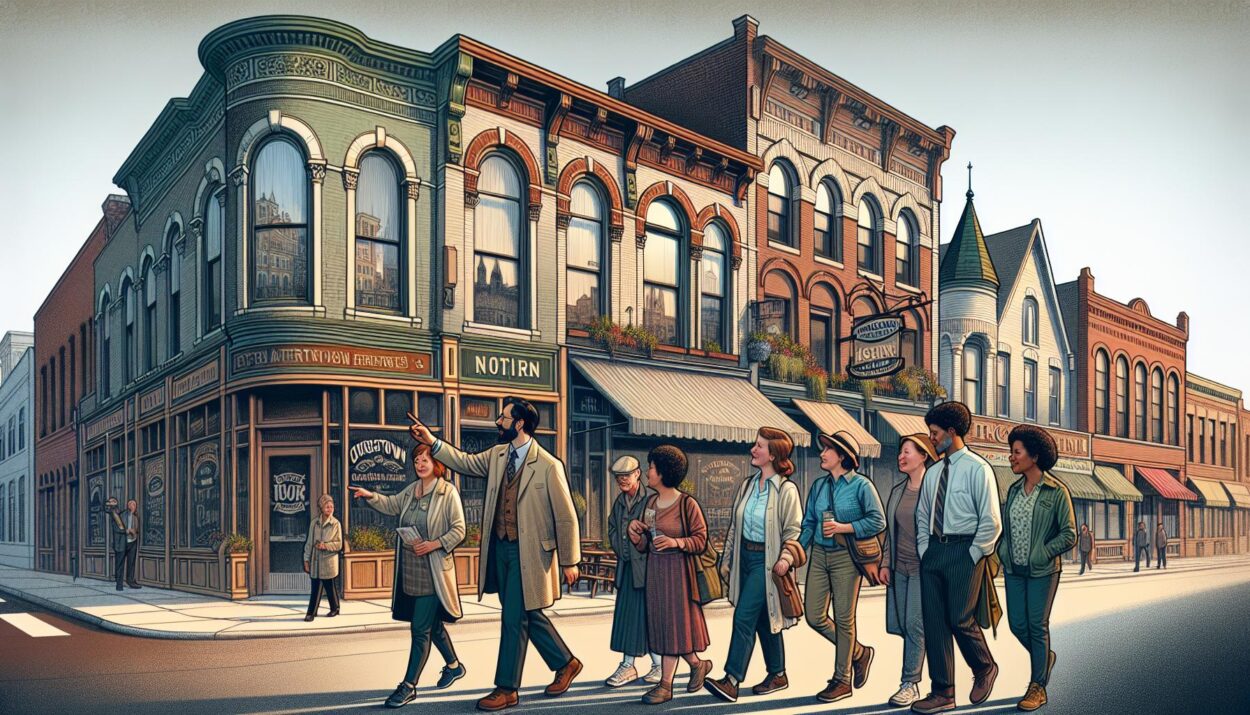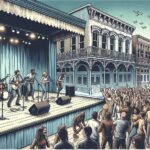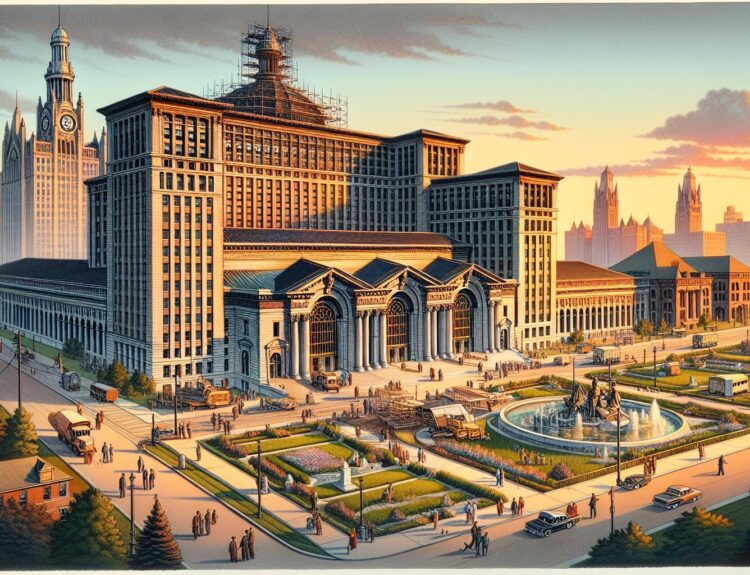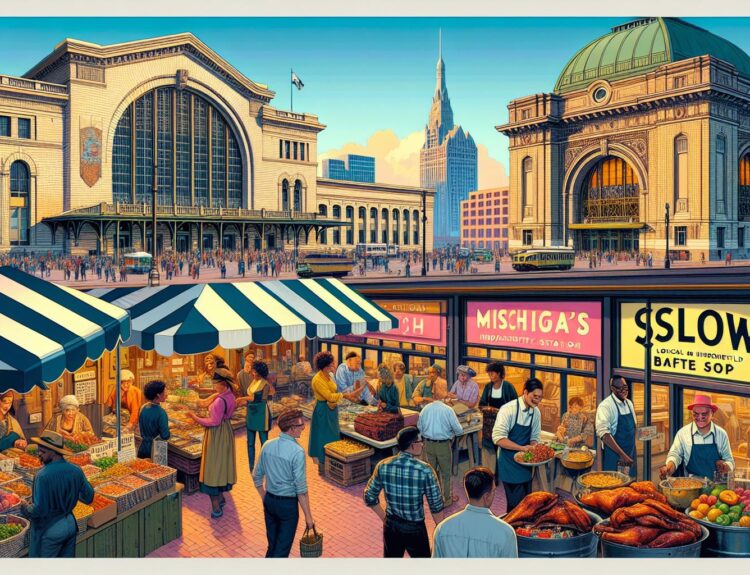Exploring Corktown, Detroit’s oldest neighborhood, is like taking a step back in time. With its vibrant history and charming streets, it’s no wonder I’ve always been drawn to this area. From the iconic Michigan Central Station to the cozy Victorian homes, there’s a story around every corner waiting to be discovered.
I recently had the chance to dive deeper into Corktown’s past through one of the many historical tours offered. It was an eye-opening experience that not only showcased the beauty and resilience of the community but also highlighted the rich tapestry of stories that have shaped this unique part of Detroit. Join me as I share some of the highlights and insights from my journey through Corktown’s storied streets.
Exploring Corktown, Detroit
As I wandered through Corktown, Detroit, with my tour group, it became clear that this wasn’t just a neighborhood; it was a living tapestry of American history. Every brick seemed to whisper tales from the past, and every street corner held a story waiting to be told. Here’s what stood out to me during our exploration.
Michigan Central Station was our first major stop. Once a bustling hub of activity, its towering façade is now a poignant symbol of Detroit’s resilience and ambition for the future. Plans for restoration have the community buzzing with excitement, envisioning a reborn landmark that bridges the past and the future.
Walking down Michigan Avenue, I was struck by the seamless blend of old and new. Historic buildings house modern businesses, cafes, and bars that breathe new life into the storied streets. This juxtaposition is not just visually striking; it’s a testament to Corktown’s enduring spirit.
One of the most engaging aspects of the tour was the stories of Corktown’s residents. From Irish immigrants seeking a new beginning in the 19th century to artists and entrepreneurs fueling the district’s renaissance today, these narratives are the threads connecting Corktown’s rich tapestry.
Our guide pointed out the quaint Trumbull and Porter Hotel, which showcases local art and goods, offering visitors a unique way to connect with Detroit’s creative community. It was fascinating to learn how businesses like these are catalysts for transformation, blending local heritage with contemporary culture.
The highlight for me was visiting Tiger Stadium’s historic site at the corner of Trumbull and Michigan Avenue. Now a public park, it’s a place where generations of memories converge. Standing there, I could almost hear the echoes of cheering crowds and feel the palpable excitement that once filled the air.
Corktown’s Green Spaces also caught my attention. Amid the urban landscape, spots like Roosevelt Park provide a serene oasis, reminding us of the importance of balance between development and nature. These areas aren’t just beautiful; they’re vital for the community’s well-being.
With every step through Corktown, it became clearer to me that this neighborhood is more than its architecture and streets – it’s a vibrant community with a soul. The historical tour didn’t simply show me places; it invited me into stories of perseverance, innovation, and community that continue to shape Corktown today.
Michigan Central Station
Stepping onto the grounds of Michigan Central Station, I couldn’t help but feel like I’d entered a time capsule. This architectural marvel, once the tallest train station in the world, stands as a testament to Detroit’s ambitious spirit. Its Beaux-Arts facade, despite years of neglect, still commands respect and admiration.
The station’s history is as rich as it is tumultuous. Opened in 1913, it was the epitome of luxury and innovation. However, as car ownership became the norm and Detroit’s economy shifted, the station saw a gradual decline. By 1988, the last train had departed, leaving the building to face an uncertain future.
But here’s the twist: Michigan Central Station is far from forgotten. Ford Motor Company acquired the property in 2018 with plans to transform it into a vibrant hub for innovation. This restoration project isn’t just about reviving a building; it’s about rekindling the energy of an entire neighborhood.
As I walked through the surrounding area, I couldn’t help but feel inspired by the potential surrounding this grand structure. The planned development includes not only the station itself but also the creation of a community space that invites interaction and growth. Ford’s vision extends to fostering a collaborative environment for tech companies, entrepreneurs, and the community.
One of the most captivating stories I came across involves the Secret Room on the station’s top floor, which was rumored to have been used during Prohibition. While its true purpose remains a mystery, it adds to the intrigue and mystique of the station.
The restoration efforts are not just aimed at preserving history. They’re focused on sustainability and innovation, with plans for green spaces, retail, and residential areas. The station is set to become a cornerstone in Detroit’s journey towards becoming a future-forward city.
Exploring Michigan Central Station and its surrounding developments, it’s clear that this is more than a renovation project. It’s a symbol of Detroit’s resilience and its capacity for rebirth. With such a rich past and an even brighter future, the station is poised to once again become a bustling gateway for the city, blending the legacy of the past with the innovation of the future.
Victorian Homes of Corktown
As I wandered through the historic streets of Corktown, Detroit’s oldest neighborhood, I couldn’t help but be captivated by the beautifully preserved Victorian homes that dot the landscape. These architectural marvels, built primarily during the late 19th and early 20th centuries, tell a story of a time when Detroit was burgeoning into a major industrial city. Each home, with its intricate designs and vibrant colors, feels like a step back in time, providing a tangible connection to Detroit’s rich history.
One of the most striking features of Corktown’s Victorian homes is their diverse architectural styles. From Gothic Revival to Queen Anne and Italianate, the variety is astounding. What’s even more fascinating is how these homes reflect the social and economic conditions of their era. For instance, the more elaborate Queen Anne homes, known for their ornate decorations and asymmetrical forms, were often owned by the more affluent members of society.
During my tour, I learned that many of these homes have been meticulously restored by passionate homeowners, committed to preserving their historical integrity while also making them suitable for modern living. It’s a delicate balance, yet walking through these neighborhoods, it’s clear that the community’s efforts have paid off beautifully.
Several homes stand out for their historical significance and unique stories. For example, the Thomas Magee House is not just a stunning example of Second Empire architecture but also a testament to Detroit’s entrepreneurial spirit, having housed various businesses throughout its history. Another notable home is the Sean O’Callaghan House, recognized for its striking Italianate design and its role in hosting community gatherings.
For history enthusiasts and architecture buffs alike, a visit to Corktown offers an unparalleled glimpse into the past. It’s not just the visual splendor of these Victorian homes but their stories, the tales of the people who once lived in them, that truly fascinate. Walking through these streets, I was reminded of the resilience and beauty that define Detroit.
If you’re planning a visit, make sure to check out the guided historical tours that delve deeper into the fascinating stories behind these Victorian gems. It’s an experience that not only showcases the architectural beauty of Corktown but also its enduring spirit.
Historical Tours of Corktown
When I first set foot in Corktown, Detroit’s oldest neighborhood, I was struck by its vibrant energy mixed with historical charm. It’s no wonder that historical tours here are not just walks down memory lane but immersive experiences that resonate with enthusiasts of history and architecture alike. During my exploration, I discovered that Corktown offers a range of tours, each providing a unique perspective on the area’s rich past.
One of the most popular options is the Guided Historical Walking Tour. This tour takes you on a leisurely stroll through Corktown’s streets, with stops at notable Victorian homes like the Thomas Magee House and the Sean O’Callaghan House. The guides are incredibly knowledgeable, sharing stories that paint a vivid picture of what life was like during the neighborhood’s heyday. They delve into the architectural details of each building, explaining the significance behind Gothic Revival, Queen Anne, and Italianate designs. Their passion for preservation is infectious, making it impossible not to fall in love with the area’s history.
For those who prefer exploring at their own pace, the Self-Guided Tour App is a fantastic alternative. The app offers detailed maps and descriptions, allowing you to tailor your journey to your interests. Whether it’s focusing on architectural marvels or discovering the hidden stories behind historical landmarks, this option puts the power of exploration in your hands. I found myself meandering through alleyways and side streets, each turn offering a new piece of history to uncover.
Beyond architecture, Corktown’s tours also spotlight the community’s cultural and social evolution. I joined a special tour focused on the Historical Pubs and Eateries of Corktown. It was an eye-opening experience, learning how these establishments played crucial roles in the community’s development. From historic speakeasies to beloved family-owned diners, each stop revealed another layer of Corktown’s complex identity.
Throughout these tours, what struck me most was the strong sense of community pride. Local historians and residents alike are deeply committed to preserving and sharing the stories of Corktown. Their dedication is a testament to the neighborhood’s resilience and charm.
Uncovering Stories of Corktown
As I wandered deeper into the heart of Corktown, the layers of time seemed to peel back with every step. It’s remarkable how every building, street, and corner in this neighborhood has a story waiting to be told. Amidst the Victorian facades and historic pubs, the stories of Corktown began to unfold through the immersive tours I experienced.
The Spirit of Innovation was palpable, reflecting in tales of the pioneers who shaped Corktown. The neighborhood was not only a home to residential Victorian beauties but also a testament to the industrious spirit that propelled Detroit forward. Legendary figures like Thomas Edison, with his brief but impactful stint in Corktown, painted a vivid picture of a community that thrived on innovation.
But Corktown isn’t just about the grand narratives of industry and progress. It’s in the whispers of everyday life where the real magic lies. The guided tours introduced me to intimate stories of the locals: shopkeepers, artisans, and families whose generations molded Corktown’s soul. These narratives, rich and diverse, weave a tapestry of community resilience and solidarity that’s hard to find elsewhere.
One cannot overlook the significant role Corktown has played in Detroit’s cultural and social scenes. Historical pubs and eateries, some still standing from the 1800s, have stories etched into their walls – tales of clandestine meetings during Prohibition, of roaring jazz nights that defined an era, and of community gatherings that brought everyone closer. These spots, like the hallowed grounds of McShane’s Pub, not only serve as landmarks but as living museums, echoing the laughter and conversations of ages past.
As I ventured through the neighborhood, the transformations Corktown has undergone became evident. From the migratory waves in the 1800s that brought Irish settlers, to the recent resurgence as a hub for creativity and innovation, Corktown has remained adaptive, yet steadfast in preserving its essence. The juxtaposition of old and new creates a dynamic narrative, showcasing a community’s journey through time.
Throughout these explorations, a constant was the palpable sense of pride among the locals. Their dedication to preserving Corktown’s heritage while embracing change is inspiring. It’s a testament to the strong community bonds that have been, and continue to be, the bedrock of this historic neighborhood.
Diving into the heart of Corktown through its historical tours wasn’t just an educational journey; it was an emotional one.
Conclusion
Exploring Corktown has been like walking through a living history book where every corner tells a story. It’s not just about the buildings or the streets but the people and their unwavering spirit that truly define this neighborhood. I’ve been fascinated by how Corktown embodies a blend of the past and the present, a place where history isn’t just remembered; it’s lived. Whether you’re drawn by the tales of innovators like Edison or the cozy warmth of its historic pubs, there’s something in Corktown for everyone. My journey through Detroit’s oldest neighborhood has been an eye-opening experience, reminding me that history is not just about the big events but also the daily lives of people who make a place what it is. Corktown, with its rich heritage and vibrant community, is a testament to the enduring spirit of Detroit.






